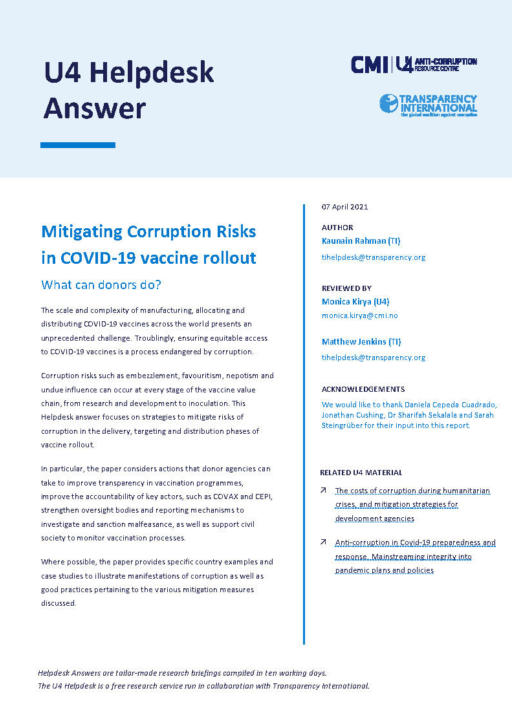
This Anti-Corruption Helpdesk brief was produced in response to a query from a U4 Partner Agency. The U4 Helpdesk is operated by Transparency International in collaboration with the U4 Anti-Corruption Resource Centre based at the Chr. Michelsen Institute.
Query
What concrete steps can donors and countries receiving vaccines take to mitigate risks of diversion and corruption related to the COVAX COVID-19 vaccine rollout?
Summary
The scale and complexity of manufacturing, allocating and distributing COVID-19 vaccines across the world presents an unprecedented challenge. Troublingly, ensuring equitable access to COVID-19 vaccines is a process endangered by corruption. Corruption risks such as embezzlement, favouritism, nepotism and undue influence can occur at every stage of the vaccine value chain, from research and development to inoculation. This Helpdesk answer focuses on strategies to mitigate risks of corruption in the delivery, targeting and distribution phases of vaccine rollout.
In particular, the paper considers actions that donor agencies can take to improve transparency in vaccination programmes, improve the accountability of key actors, such as COVAX and CEPI, strengthen oversight bodies and reporting mechanisms to investigate and sanction malfeasance, as well as support civil society to monitor vaccination processes. Where possible, the paper provides specific country examples and case studies to illustrate manifestations of corruption as well as good practices pertaining to the various mitigation measures discussed.
Contents
- Background
- Corruption risks
- Mitigation measures
- Trade-offs: expediency vs integrity
- References
Main points
- The nature and scale of the COVID-19 vaccine rollout makes oversight difficult, which exacerbates corruption risks in the distribution, targeting and delivery of vaccines. These risks include nepotism, favouritism, embezzlement, conflict of interest, undue influence, bribery and leakages in resources intended for the vaccine rollout.
- Several ongoing initiatives to tackle these corruption risks are taking place in several countries. This paper extrapolates from these to consider interventions that could be relevant for donor agencies.
- Donors can take a number of short-term measures, including supporting transparency initiatives and helping to strengthen monitoring and reporting mechanisms. Longer term strategies involve embedding anti-corruption into emergency responses and enabling environments conducive to accountability.
Authors
Kaunain Rahman (TI), [email protected]
Reviewers
Monica Kirya (U4), [email protected]
Matthew Jenkins (TI), [email protected]
Acknowledgements
We would like to thank Daniela Cepeda Cuadrado, Jonathan Cushing, Dr Sharifah Sekalala and Sarah Steingrüber for their input into this report.
Date
08/04/2021

